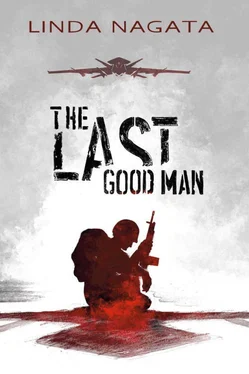“Are you ready to go home?” she’d asked him, when they’d been on the road only a few minutes and were getting to know one another.
He flashed a shy smile, just visible in the dash lights. “Hell, yes. I’ve been ready for months, but I wanted to burn the last of my currency on something worthwhile.” He nodded. “As soon as I confirmed with Chris who you were after, I knew this was it.”
There are advantages to being nearly fifty. One of them is a face that shows some mileage. Not that this is always an advantage, but once True puts on a hijab, without the prosthetic of makeup, those features she has earned through time—the slender white scar on her right cheek, the dark brown age spot on her left jaw, her mother’s jowls that gravity insists on pulling into wrinkled relief—ensure that no man on the street looks at her twice. Not even those two youths slouching beside the gate of the house where Hussam is staying, automatic rifles in hand.
The two young Al-Furat guards exchange terse greetings with the townsmen who walk by, but both look right past True. Really, they should know better. Older women can be dangerous too. In the TEZ they have smuggled weapons, carried information, served as spies and as suicide bombers. Perhaps these two don’t know that. Or maybe they’ve heard of such things but they don’t believe it or don’t believe it’s important. True suspects they are simply selectively blind to a woman, any woman, over a certain age who is not a close relative.
On another day in another place, that might irritate her. Today she is cheered that not a single man takes notice as she hobbles past in her black abaya, walking with short steps as if suffering arthritic knees. If they see her at all, she wants them to see her as a harmless grandmother with a shapeless waistline—courtesy of the body armor she wears—and stooped shoulders that disguise her height.
The two guards are watching the street through Sasszem lenses—a Hungarian version of augmented reality glasses specialized for security officers. ’Zems offer only a few options, but they’re far cheaper than MARCs, they’re not constrained by stringent export restrictions, and they’re good at what they do—which is to visually monitor a shifting milieu for weapons and for aberrant behavior. In addition, a facial recognition service is available by subscription.
It’s likely these guards are subscribed—so there is one more possible reason they overlook True, a more excusable reason: Their software will have failed to tag her with a name, because Lincoln purchased identity restrictions from Global Asset Tracking.
GAT is a profiling company that specializes in matching names and faces around the world. Most of the hundreds of apps designed to identify strangers work from GAT’s database and those that don’t aren’t worth a damn outside of limited regions. The faces GAT fails to recognize are nearly all of two kinds: those with the money to buy anonymity, and those at the opposite end of the social spectrum, with no choices, no money, and no future. An old woman with arthritic knees, for example, hobbling on some errand through the dusty streets of Tadmur.
True milks the role, moving slowly, biding her time, waiting for elements to shift. When a white sedan approaches the compound’s gate, she hobbles a little faster. The sedan is new, four doors, black-tinted windows, a hood ornament. Dust hazes its reflective shine. As it noses up to the gate, the driver’s window slides down. One of the guards steps up to confer while True ambles past the back bumper, one hand in a pocket of her abaya.
The sun’s reflection flares in the chrome, blinding her. She squints, ducks her head, stumbles—and shoves two kamikaze crabs through a slit in the bottom of her pocket. Hidden by her abaya, they strike the road’s dusty surface with a light clatter.
They are sand-colored robots, made of two hard plastic ovals with a layer of C4 sandwiched between. Remotely operated, they have just enough processing power to move quickly on their four jointed legs. Guided by Lincoln, or someone on staff at ReqOps’ command post, they scuttle from beneath the abaya’s hem into the shadow of the car.
As the car rolls through the gate, the kamikaze crabs go with it, using the vehicle for cover. Their targets are the two trucks parked inside. They will attach to the engine blocks and then, if Hussam decides to leave Tadmur today, it will be an easy matter to detonate the crabs and disable the vehicles in the open desert. If not, the engines will be blown up tonight after the hostages are recovered, eliminating the trucks as a means of pursuit.
True hobbles away from the target house without looking back, an old woman, unnoticed by anyone.
Eventually she makes her way back to Khalid’s apartment where Rohan greets her with a wolfish smile.
“It worked, Mama,” he tells her. “The kamikazes are in position.”
~~~
By afternoon, the buzzing ceiling fan in Khalid’s little apartment is stirring unseasonably warm ninety-degree air. True lies on her back, distracted by the ceaseless movement of the fan’s spinning blades just visible past the edge of a three-dimensional schematic projected by her visor, and by the weird warmth of the generated breeze, like breath against her skin.
She occupies exactly half the mattress, refusing to let Jameson squeeze her out of her turf. He’s asleep—she’s sure he’s asleep because he’s been snoring softly for a good ten minutes, but every time he shifts position his massive shoulder presses a little harder against her. His T-shirt is damp with sweat, its scent sweet, thick. Vaguely arousing.
Rohan has taken his shirt off. Somewhere on the other side of the mountain that is Jameson, he sleeps on the floor, head pillowed against a neatly folded jacket. Felice and Juliet share the worn carpet’s thin padding. Felice has stripped down to shorts and sports bra. Sweat gleams on her bare brown skin. She’s awake, lying on her back like True, eyes blinking occasionally behind the screen of her visor. Her hands are at her sides, her fingers curling and twitching within data gloves as she studies some scenario. Juliet, wearing T-shirt and shorts, is curled beside her. Her MARC is in its case; her eyes are closed in sleep.
Khalid is out, rustling up fares. Nothing unusual here.
No one is on watch. They don’t need to be, because ReqOps’ staff, half a world away, has the entire town under surveillance.
Specific surveillance continues to be directed at the target property. The schematic True is studying is a three-dimensional projection of the house showing the outlines of rooms, the layout of furnishings, and the ghostly figures of people. It was developed from a radar sweep conducted by an Eden Transit UAV. No way to know for sure which of the six figures on the ground floor is Fatima. But the three individuals on the second floor, confined in a storeroom, are certainly the surviving male hostages.
A mosquito drone collected shadowy, low-res images of their faces. The three men are thin, haggard. But are they injured? Are they ambulatory? She hopes like hell they can get themselves down the stairs.
“Wireless communications layer,” she says softly.
All active devices in the target house are pinpointed. Three mobile devices downstairs are certainly phones. An additional node of activity is a first-floor room, likely an office. The video of Noël’s execution was probably sent out for professional editing from that room.
She drops the communications layer, extends her overview to the outside of the house. Multiple images captured by wandering beetles combine to create a three-dimensional projection of the compound sheltered beneath the anti-surveillance canopy. A small fountain sits at the center of the tiled court. Around the periphery, little potted cypresses look to be thriving despite the canopy’s filtered light. The two large trucks are parked at the front of the house, to the left of the door. Two sedans are parked on the right, but those are visitors. They should be gone by the time the mission launches.
Читать дальше












